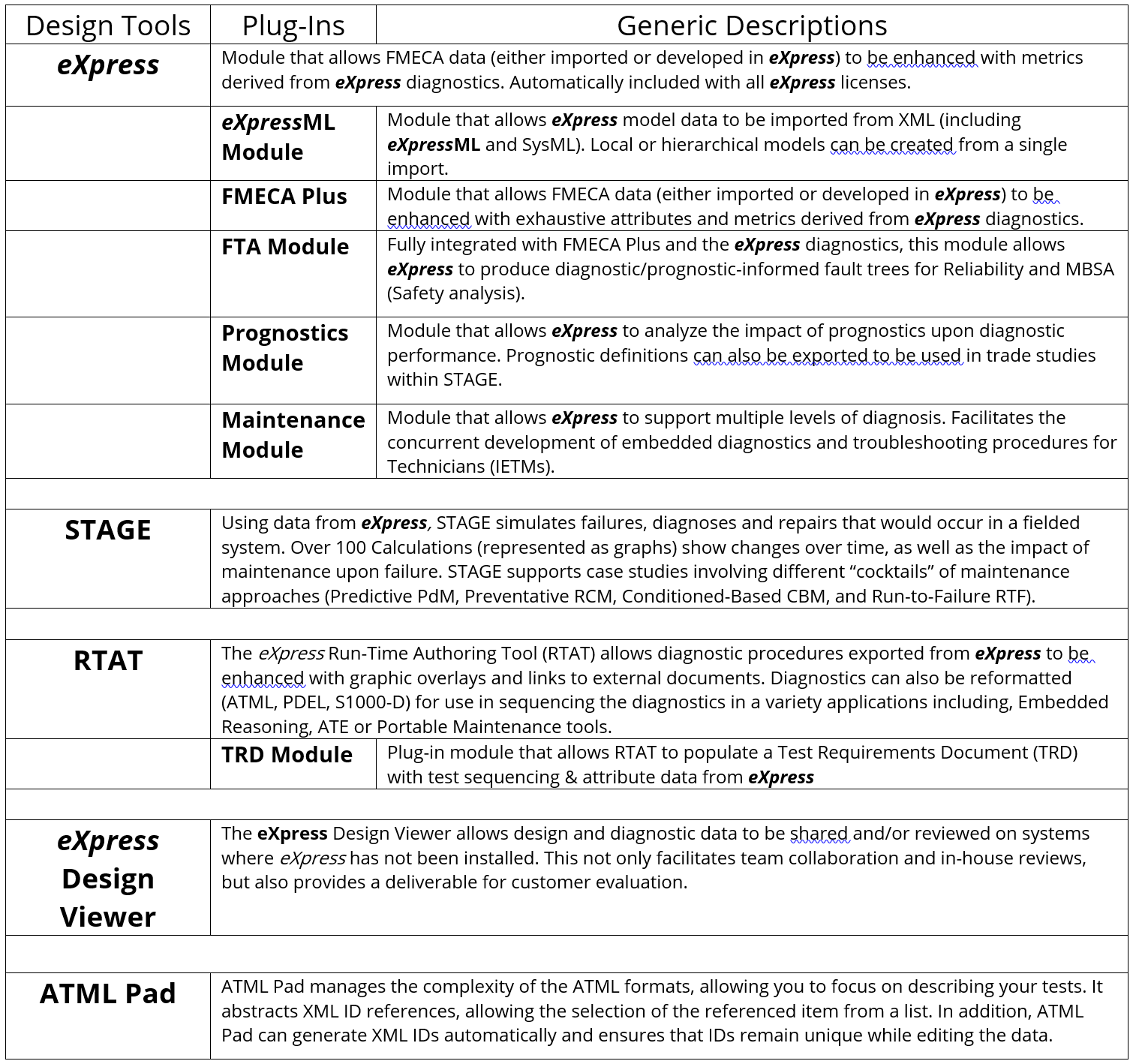

Support
Universal Approach to Model-Based Safety Analysis (MBSA)
by DSI Staff | Published 02/12/2019 | Systems Engineering
Background
A Model-based approach to ensuring functional performance on complex systems for the warfighter has been a core objective for DSI since the mid 1970’s. As computing technologies and software advanced, DSI has continued to push and lead industry in this Model-based approach to Testability and Diagnostic Analysis. DSI’s founder, Ralph A. DePaul, Jr., was recognized as pioneering “Designing for Testability” by IEEE in 1994.
By 1998, DSI’s Model-based Diagnostics Engineering tool, “eXpress”, was the first fully-featured Diagnostic Design capture and analysis tool available as a PC-based commercial product. As such, “eXpress” has matured to be the “go-to” Diagnostics Engineering tool for those large or complex Aerospace and Military programs.
Over the past decade, many other tools have been developed by DSI to greatly expand and enrich the utility of the eXpress Model-based approach to Diagnostics Engineering. Once any design is fully captured in the eXpress Model-based environment, almost any other Model-based assessment are generated as “turnkey” outputs from the captured diagnostic design – including design or system level FMEAs, FMECAs and a myriad of stock Model-based Safety Analysis Assessments.
Interoperability – Development Lifecycle – Product Lifecycle Management (PLM)
As a prerequisite to performing a Model-Based Safety Analysis and Assessment is an environment that must include any relevant design data from all interdisciplinary design activities. It must also be able to include design data in an “interoperable” form from external suppliers and that may use a variety of preferred design tools.
Any data to be included as input to the Model-based Systems Engineering (MBSE) approach must be able to be more than simply, “compatible” with industry or specialized data schemas or structures – particularly when integrating Model-based Safety Analysis (MBSA) as a fully integrated component to the MBSE process. Additionally, there must be an inherent Model—based design mechanism or utility that fully vets supplier data that performs error and validation checks to ensure completeness and accuracy before enabling inclusion into overarching system (asset-level) model(s).
Interoperability – Sustainment Lifecycle
To ensure that any investment expended into “designing for MBSA” is capable of being directly “transitioned” to the (evolving) Sustainment paradigm, the output from the MBSA must extend beyond the boundaries of the Design Development Lifecycle. It must perform this seamless transition with ease and consistency while also being capable of migrating to future technologies before inclusion into the Development and Sustainment Lifecycle(s).
Diagnostic Engineering generates the “Trade Currency” to Support high-end MBSA
As a prerequisite for high-end MBSA requirements to become an integral layer within a variety of high-end MBSE and dynamic PLM Development environments, it must have agile “trade currency” that is shared at an equally robust level in order to continue to support any design or support discipline. This will enable the data to be (re)assessed, (re)optimized, updated or revised and actively “traded” against any other interdisciplinary design assessment(s) input or output data to discover the impact on the Maintenance philosophy (requirements) at any point over the sustainment lifecycle. Model-based Diagnostics Engineering must be performed at the same elite level as the MBSA to ensure the consistency, quality and reliability of the data as it transitions from the Development Lifecycle to & throughout, the Operational & Sustainment Lifecycle. To this purpose, “Diagnostics Engineering” shall provide the “currency” to trade, balance, validate and ensure that seamless, comprehensive & ongoing transition.
Capability to Model any Complex or Large System
DSI’s eXpress software application is the core tool within an entire Model-Based Diagnostic Engineering environment that is highly interoperable with many other DSI Model-Based Reliability and Maintainability Engineering tools, but also with data from any other Reliability or MBSE tools commercially available in industry.
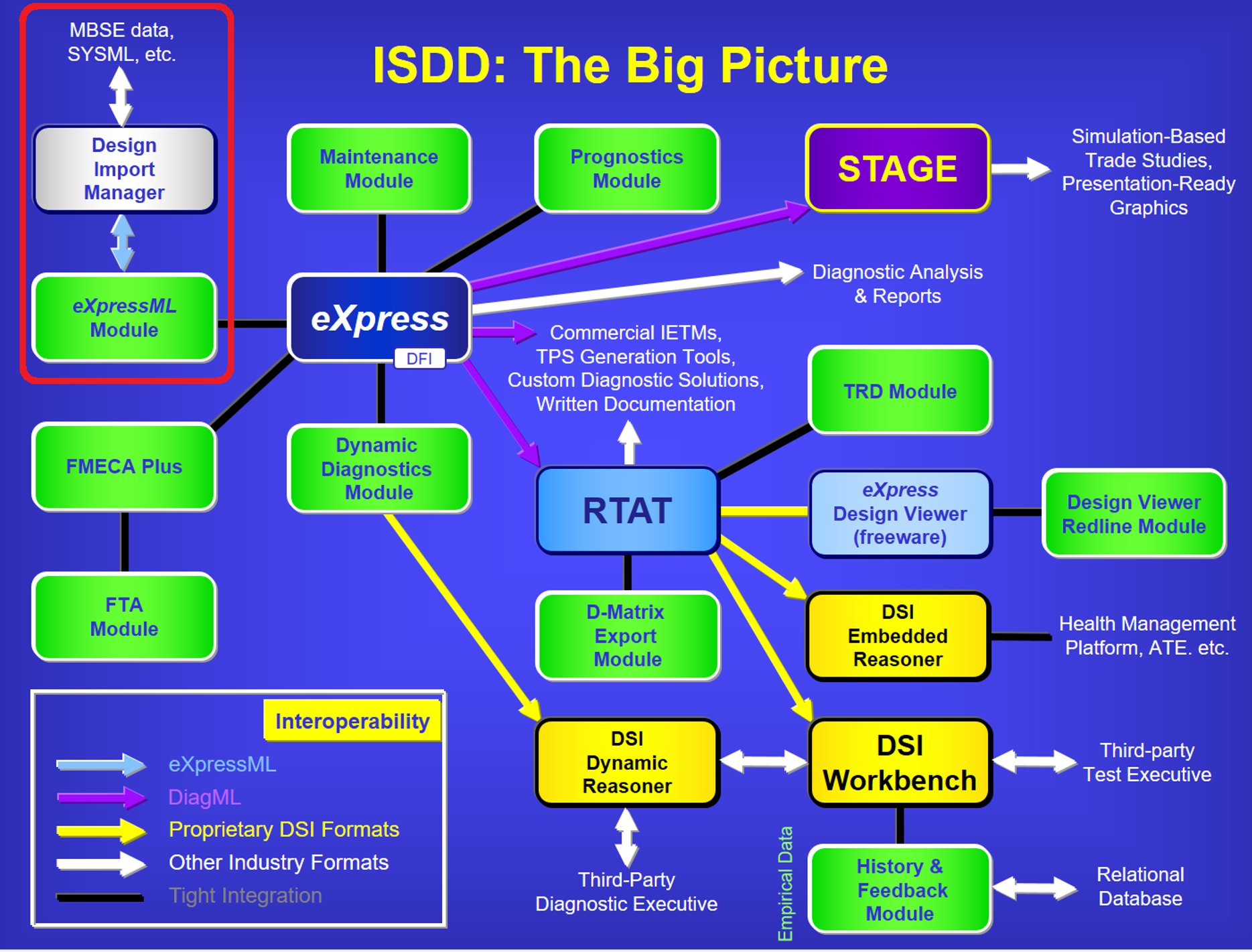
MBSE Diagnostics modeling in eXpress
Since eXpress is a high-end Model-based Diagnostics Engineering tool used throughout industry and also already at some level within (your organization) it serves as the central area of the “Integrated Systems Diagnostics Design” (ISDD) environment that enables a potpourri of alternatives to enrich any MBSE or MBSA paradigm. Notice the “double-headed” arrows on the “eXpressML” data import to eXpress, which depicts the eXpressML export from eXpress to the MBSE environment as well.
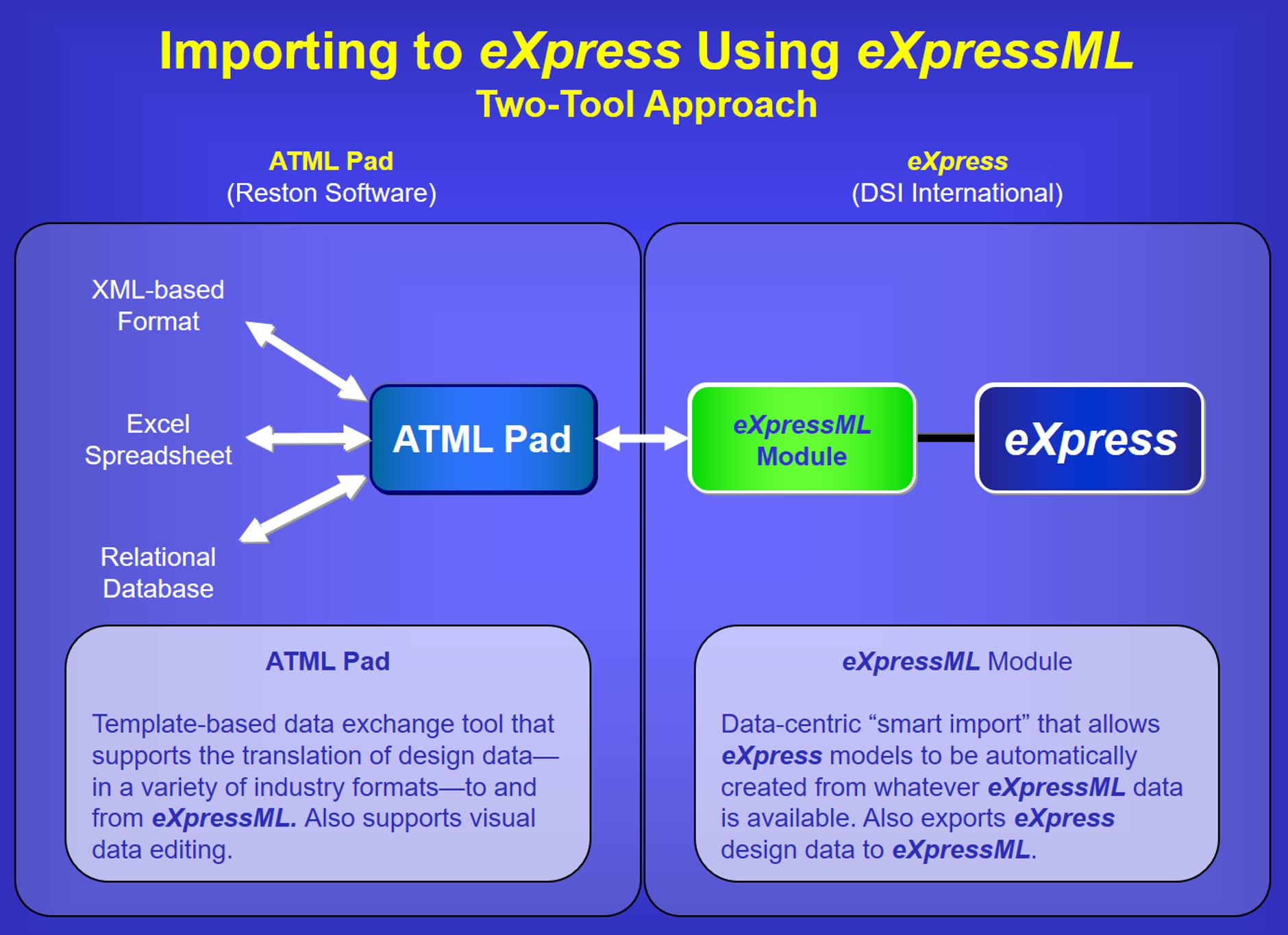
Auto-generation of the Functional Model of the designs at any hierarchical design level(s)
At its core, eXpress enables any or all of the functional and failure propagations to be captured in its “hybrid” dependency modeling paradigm, and can be performed at any time before, during or after design development. It’s fullest capability is realized when used to “influence” design decision making as it vividly reports on the “diagnostic effectiveness” of any alternative design considerations that can be immediately shared within an MBSE or externally to a secured MBSE environment. These functional and failure propagations captured within eXpress will report on the “diagnostic value and utility” of any sensors or BIT considered within the design(s) of any of lower level assemblies cards, subsystems, etc. and/or any upper-level fully integrated systems at the operational asset level or higher.
Data Validation and Analysis
In eXpress, all input and output definitions (flows and functions) are described and initially checked for modeling errors by the eXpress “Model Error Checker”. As the design matures, it is validated via several collaboration tools: The eXpress Design Viewer and the internal eXpress Desktop Fault Insertion capability (“DFI”).
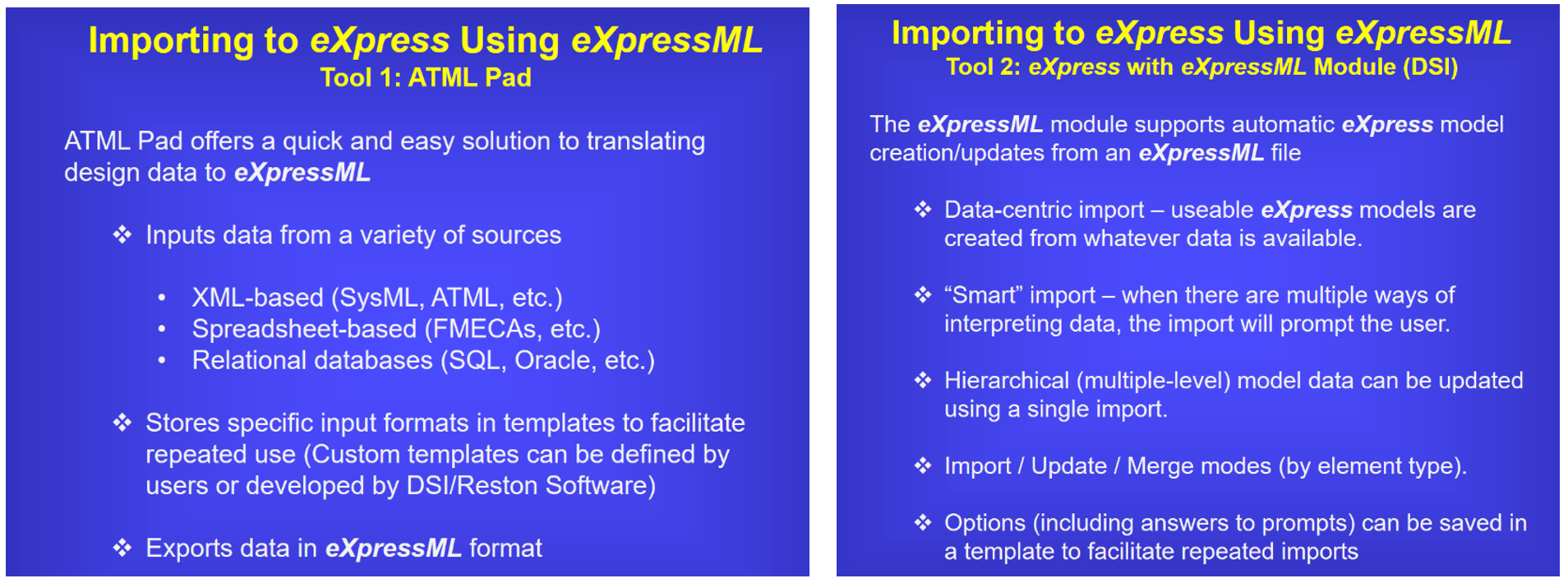
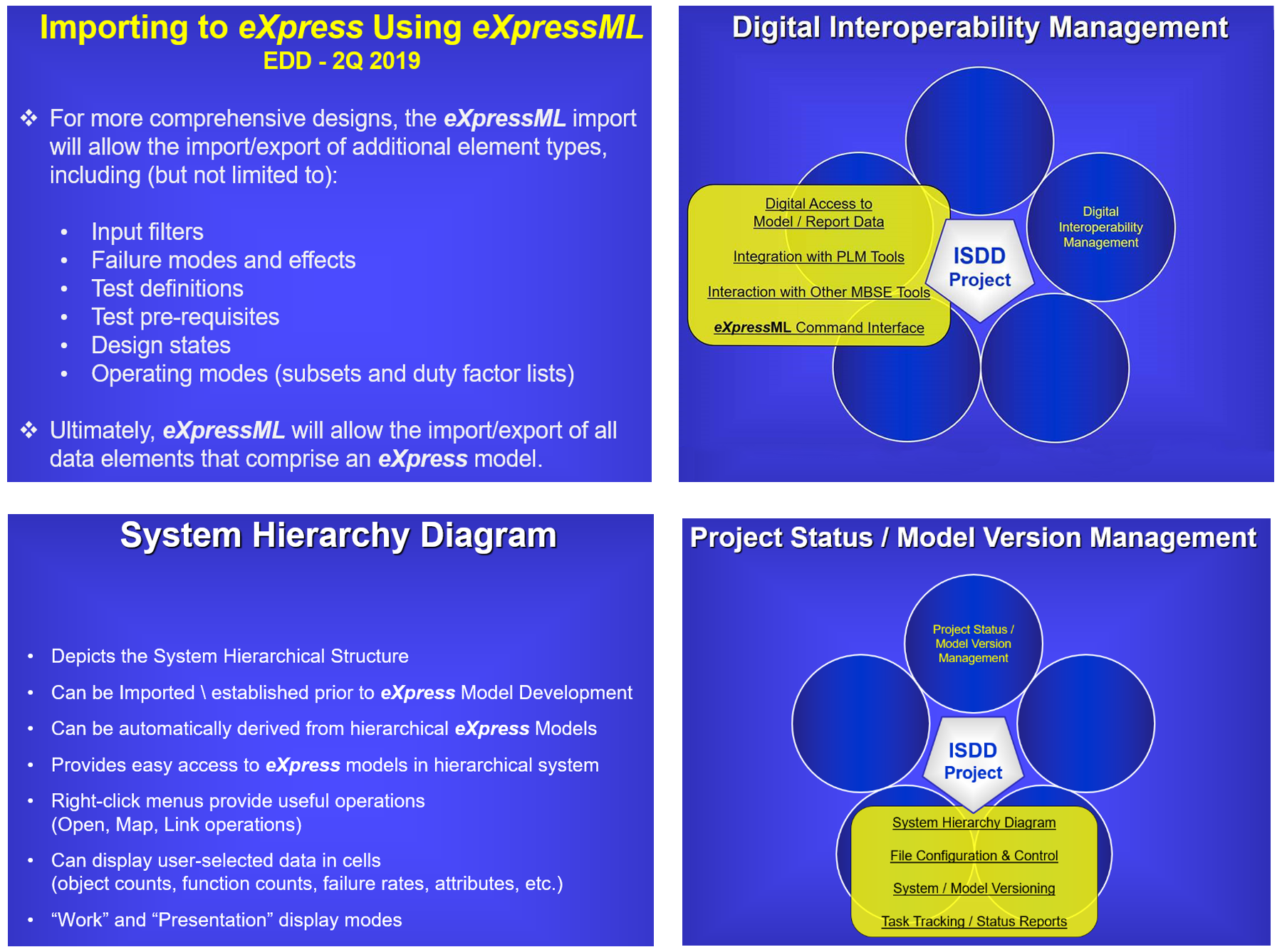
Model Scalability – a prerequisite for MBSA
Diagnostic Engineering Models of systems already performed within eXpress include complex Flight Control systems, aircraft carrier launching and arresting systems, multi-spectral targeting systems, radar and countless high-end missile systems. There is no technical limit to the domain or size of the models produced in eXpress by large military and defense, so model purpose, domain(s) or Scalability are not limitations.
Importing, reuse and repurposing of MBSE data using SysML or MS Excel
Data forms such as SysML or MS Excel (currently available) can be imported into the eXpress Model-based Diagnostics Engineering environment, which can be exported as “raw” data or “cooked” processed data for the diagnostic deployment or a myriad of purposes in the operational environment – including to the on-board or embedded diagnostic reasoning.
BIT (or Operational) “Test” Coverage
As each test and/or failure data is initially described in eXpress, in terms of its “Test Coverage” – what “Diagnostic Conclusions” are learned when any test(s) (i.e. BIT, sensor, etc.) passes, or fails. This is integral expert design knowledge that is not, otherwise captured in any MBSE or MBSA paradigm. This Test Coverage detail is considered throughout the system and full design and MBSA hierarchy (within eXpress) and can be updated or modified at any time. Any design MBSA assessments are then computed on any aspect of the design after automatically elaborating this detail, and/or any other properties. The validation of any diagnostic BIT or sensors – at any, or all design level(s), is inherent to this approach and essential to assess and ensure operational effectiveness of MBSA.
Auto-generation of Testability Assessments – Fault Detection & Fault Isolation that impact MBSA
This is a core competency of eXpress as DSI pioneered, led, and still leads industry in the computation of Fault Detection and Fault Isolation for any design and for any purpose(s) to support any complex design – operationally or otherwise throughout the its full Product Lifecycle.
The integration of the Safety and Reliability Analysis is a capability of “express”
Since the preponderance of the raw reliability data is available as “object attributes” within most advanced Reliability Engineering processes, typically in spreadsheet form, this data can be immediately imported into the eXpress design at any time or at any intervals in a MBSA & MBSE design environment. Such object attributes may include the typical component information such as failure rates, severities, reference ID’s, port names & flow, operational states, part numbers, reference ID’s, LCN, cost data, etc., or any additional attributes specified by the program. Attribute types are unlimited.
Auto-generation of Functional Failure Modes, Effects
Because eXpress is a high-end Model-based engineering tool, it is able to “auto-generate” preliminary failure modes and failure effects for any design upon completion of the functional model capture in eXpress. When more specific data is learned and desired to be “merged or swapped” into the model, the data can be easily imported, and (re)propagated whenever desired. This accentuates the agility inherent to this approach and further supports any PLM environment.
Select Failure Distribution “Attribute” for adjusting any Failure Probability
Since eXpress allows the inclusion of any type of failure probability calculation (Dormant, Weibull, Log Normal, Normal, Binomial, etc.) via a simple selection of a Failure Effect “Attribute”, the effects of these calculations are inherently considered throughout the entire design and overarching system design hierarchy.
Auto-generation of (preliminary) Functional Hazard Analyses (SAE 4761)
Because eXpress is able to include and propagate the knowledge of root failure modes, failure effects and relevant component property attributes throughout the entire design hierarchy, the preliminary Functional Hazard Analysis can be auto-generated as an output product and/or described in a form that is traceable and mapped to the WBS.
Auto-generation of FMEA & FMECA Assessment products
Since eXpress is able to capture the functional and failure propagations within the context of discovering the diagnostic integrity of the design(s), it using any available Reliability (and Maintainability) data that also enables the automatic generation of the Traditional “standard” FMEA or FMECA’s (MIL-Hdbk 1629A) but allows full customization.
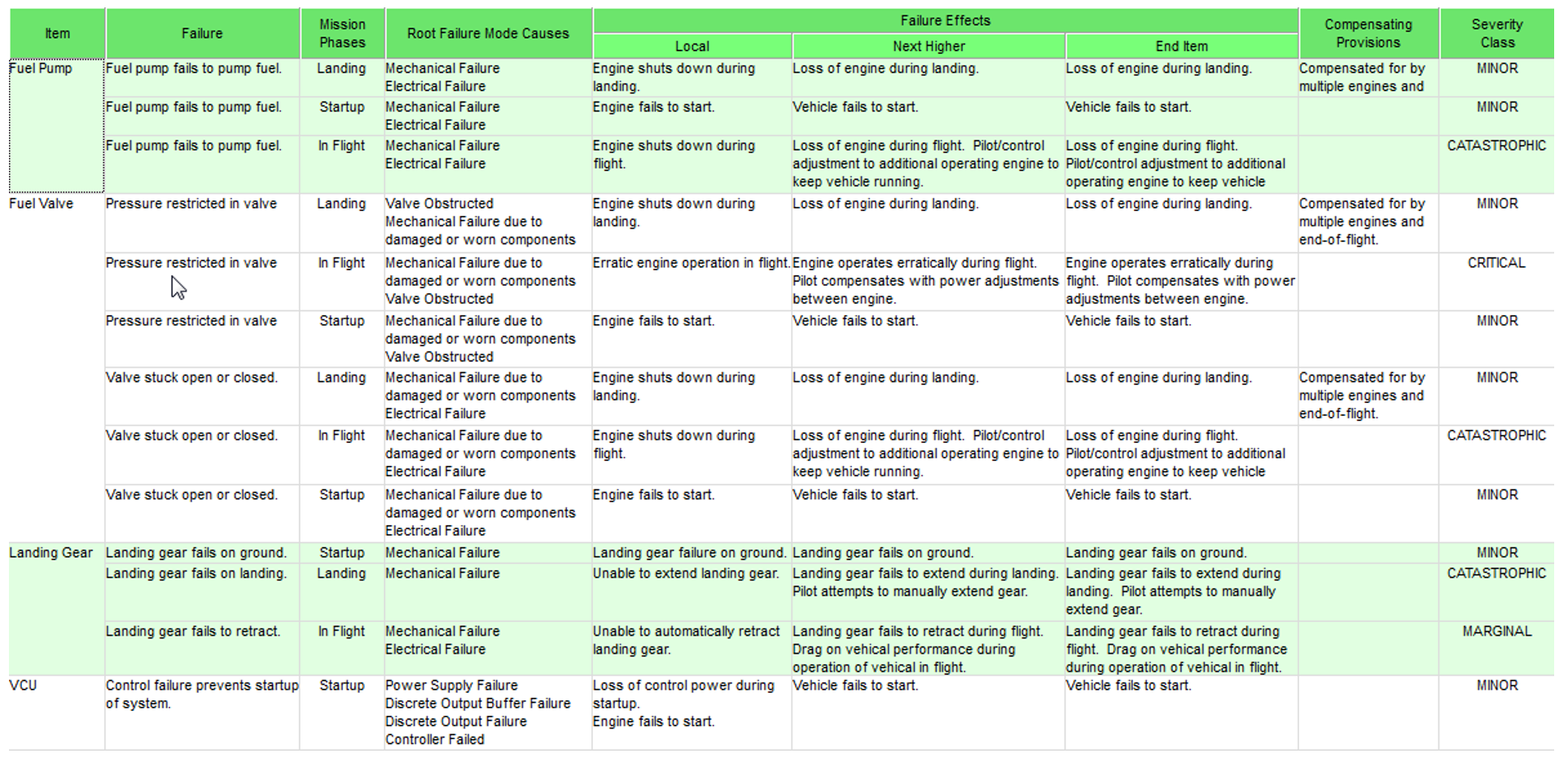
Auto-generation of FMEA & FMECA Assessment products – upon demand to Support MBSA
Additionally, eXpress enables any desired number of columns to be added and adjoined within the FMECA to describe such diagnostic details about each component as Failure Detected, Number of Root Failure Modes in each Fault Group and the size & constituency of that Fault Group. It can also describe if the Failure is “Uniquely Isolated” in this “Diagnostics-Informed” FMECA, as well as being identified as “FUI” in any Reliability Assessment products generated as outputs from the eXpress Model (see images of FTA below). Not fully discovering and considering the impact of FUI will have a negative impact on the operational value realized from any MBSA.
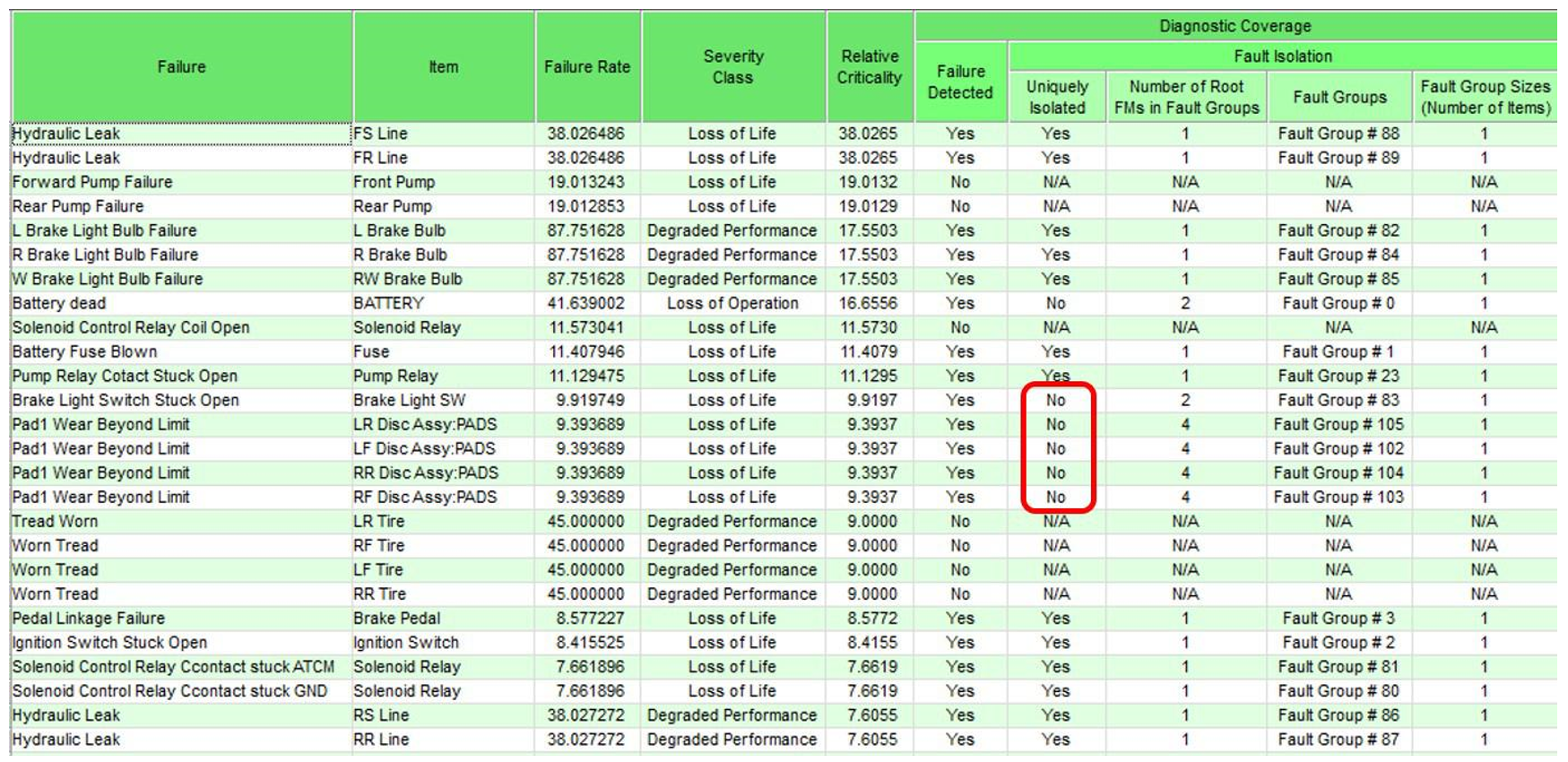
Auto-generation of eXpress Fault Tree Analysis
The eXpress Fault Tree Analysis (FTA) is calculated and produced as an “output” from the captured diagnostic design in eXpress (see image below). Unique to the eXpress FTA is that each node of the FTA will identify the probabilities of detecting a failure at any node (“FD”) of the FTA – and the percentage of that Failure that can be “Uniquely Isolated” (identify the “root cause” to a specific Failure Mode) at that node in the FTA – integral to a high-end MBSA process. The inability to discern the specific root cause (Failure Mode) is a heavy contributor to False Alarms and Operational Aborts.
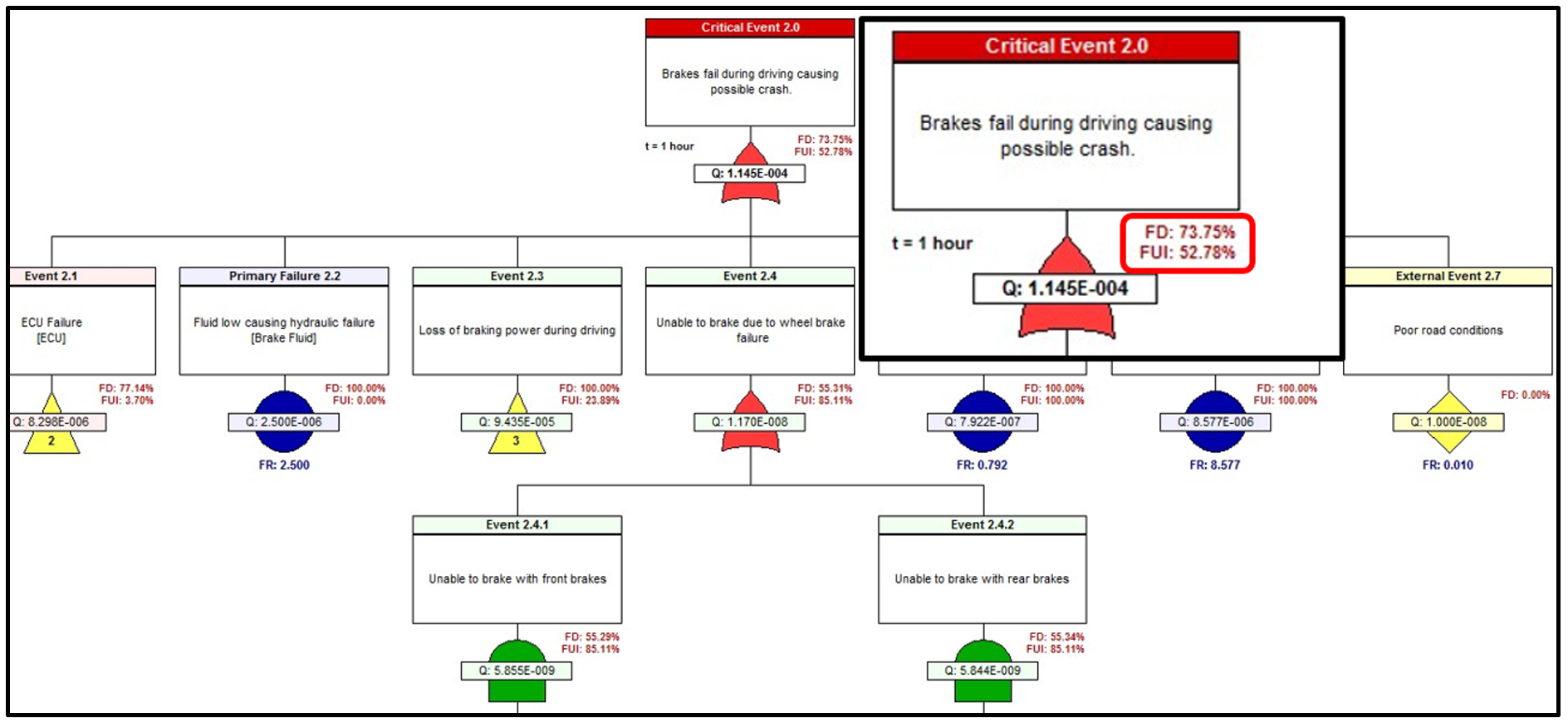
Reporting of FTA “Cut Sets” in the eXpress FTA & FMECA
Simultaneous Auto-generation of eXpress “Critical Failure Diagnoses Chart” (Diagnostics-Informed FMECA: second image above) and the interdependent eXpress Fault Tree Analysis (FTA) at any point during design development. This critical Reliability Assessment product ensures cross-validation between the FMECA and the FTA. Both the FMECA and FTA assessment products are generated using the same diagnostic knowledgebase from the eXpress Model. The typical “Cut Sets” are also co-identified within the FMECA and/or the FTA. Concurrently, automated detailed “Cut Set” reports produced by eXpress for any FMECA/FTA generated in eXpress along with the full breadth of traditional Safety Assessment reports (Cut Set Details, Important Measures, etc.) but also a “Failure Mitigation Report” to discover mitigated single-point failures.
Furthermore, and since all of these companion assessment products are generated as co-dependent outputs from any model or system model within eXpress, any variation, change or update to the eXpress model(s) during the development process can be immediately reported back into the PLM or high-end MBSE design development processes for SME validation and further MBSA trade study analyses. Refer to an example of the eXpress FMECA/FTA toggle capability and the FTA Cut Set outputs in the image below:
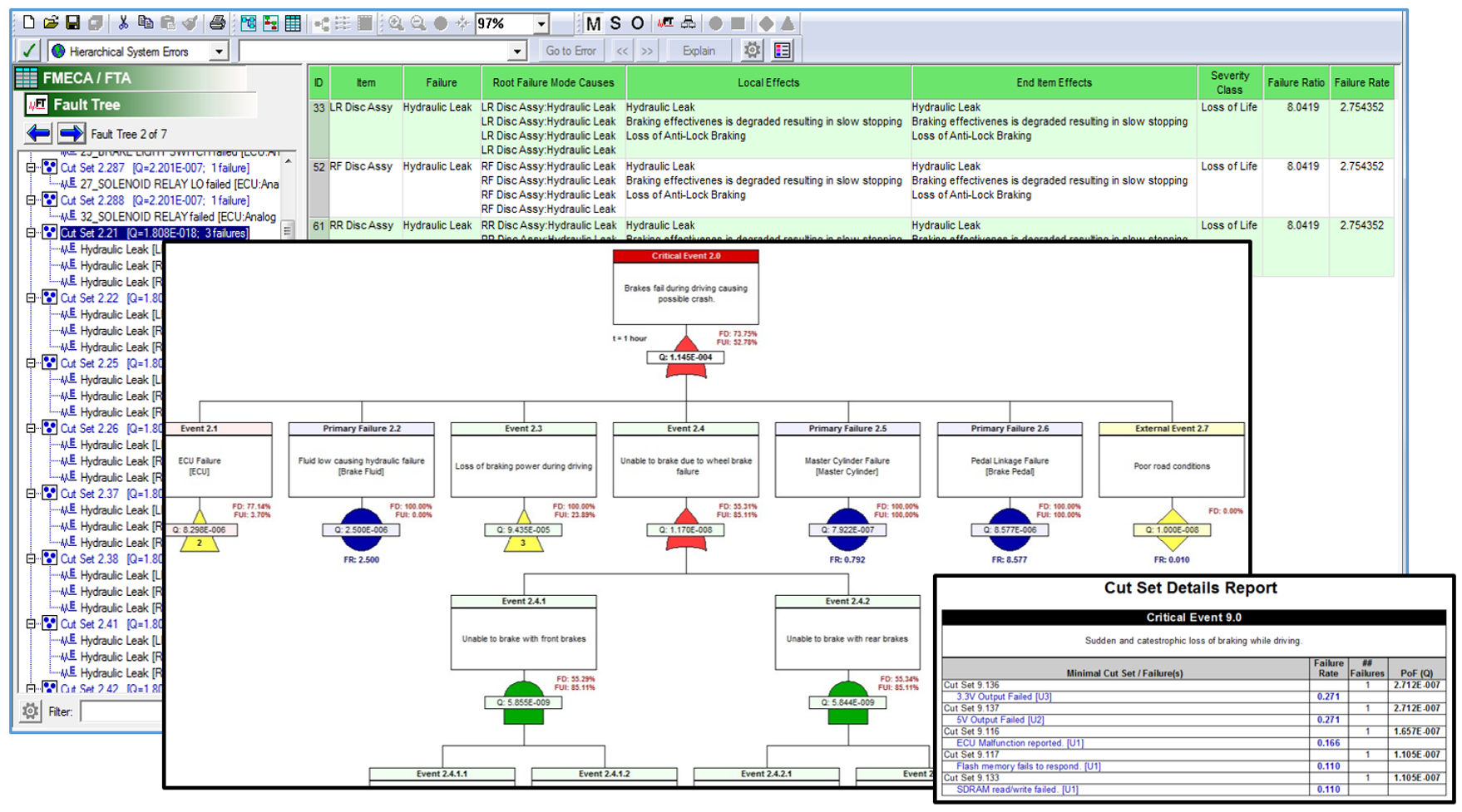
MBSA Value Transitioned to Operational Environment
Without equally high-end Diagnostics Engineering, any investment into MBSA within an MBSE environment, will not be able to ensure that the operational level (or any ensuing maintenance level continued thereafter) implementation of the Health Monitoring/Managing will be able to be fully realized. To discover the strengths and weaknesses of the MBSA as it corresponds to the operational environment it would require that the MBSA be compared to results learned from the performing of an operational support simulation whereby any failures can be simulated during any mode or operational state of operational vehicle or asset.
The Simulation of failures to Ensure Accuracy of Corrective Action(s)
The simulation of failures will allow us to examine if the critical failure(s) can be detected or decisively isolated to any critical root cause (failure mode) as declared in the MBSA within the companion FMECA, at the operational System’s level. While the eXpress FMECA/FTA identifies such Safety Assessment metrics to be determined and included within any selection of static report forms, the “STAGE” operational support simulation will determine the impact of the occurrence of any possible failure(s), including critical failures, during any specified “Sustainment Lifetime”. The “STAGE” Simulation will allow the assessing of any mixture of maintenance paradigms of Run-to-Failure (RTF), Preventative (RCM), Conditioned-Based (CBM) and Predictive (PdM) to analyses operational trades, benefits, degradations and costs in over 100 graphs.
Operational Support & MBSA Simulation – Since the STAGE Simulation is cognizant of:
1) The “Test Coverage” of each and every sensor (BIT) & all Diagnostic Fault Group Constituency
2) All Failures that are and are not Detectable at specific periods during any Operational Diagnostic Interrogation
3) Includes all Failure Rate, Failure Modes data & computes Failure Propagation knowledge throughout the System
4) Considers the Realization of how a System is maintained impact how it fails throughout the Sustainment Lifecycle.
Refer to the initial outputs from the STAGE Simulation that are relevant for core MBSA metrics in the images below:
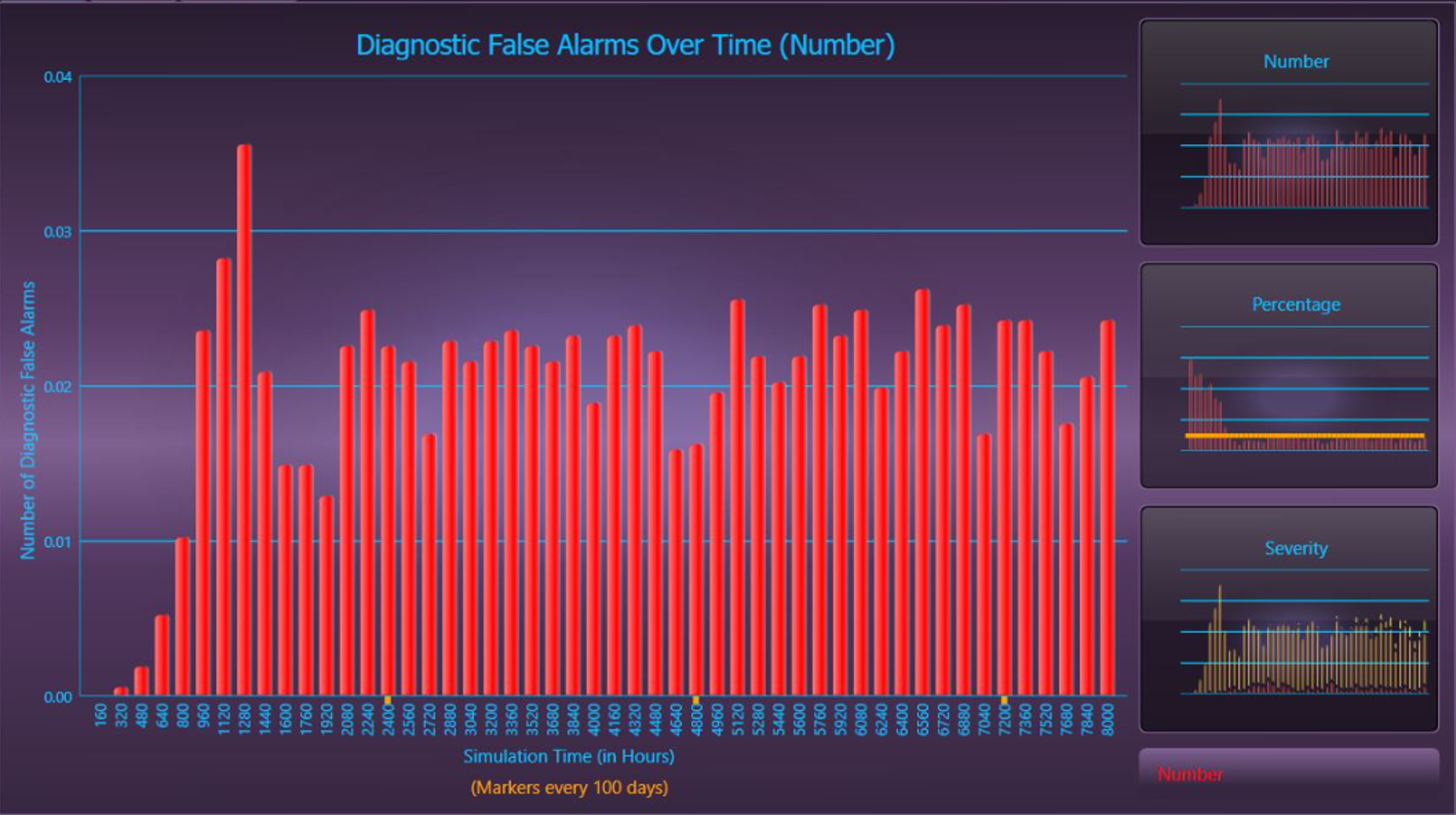
Diagnostic False Alarms (False Alarms due to constraints in Diagnostic Design)
Graph considers Replacements due to any Maintenance Activities
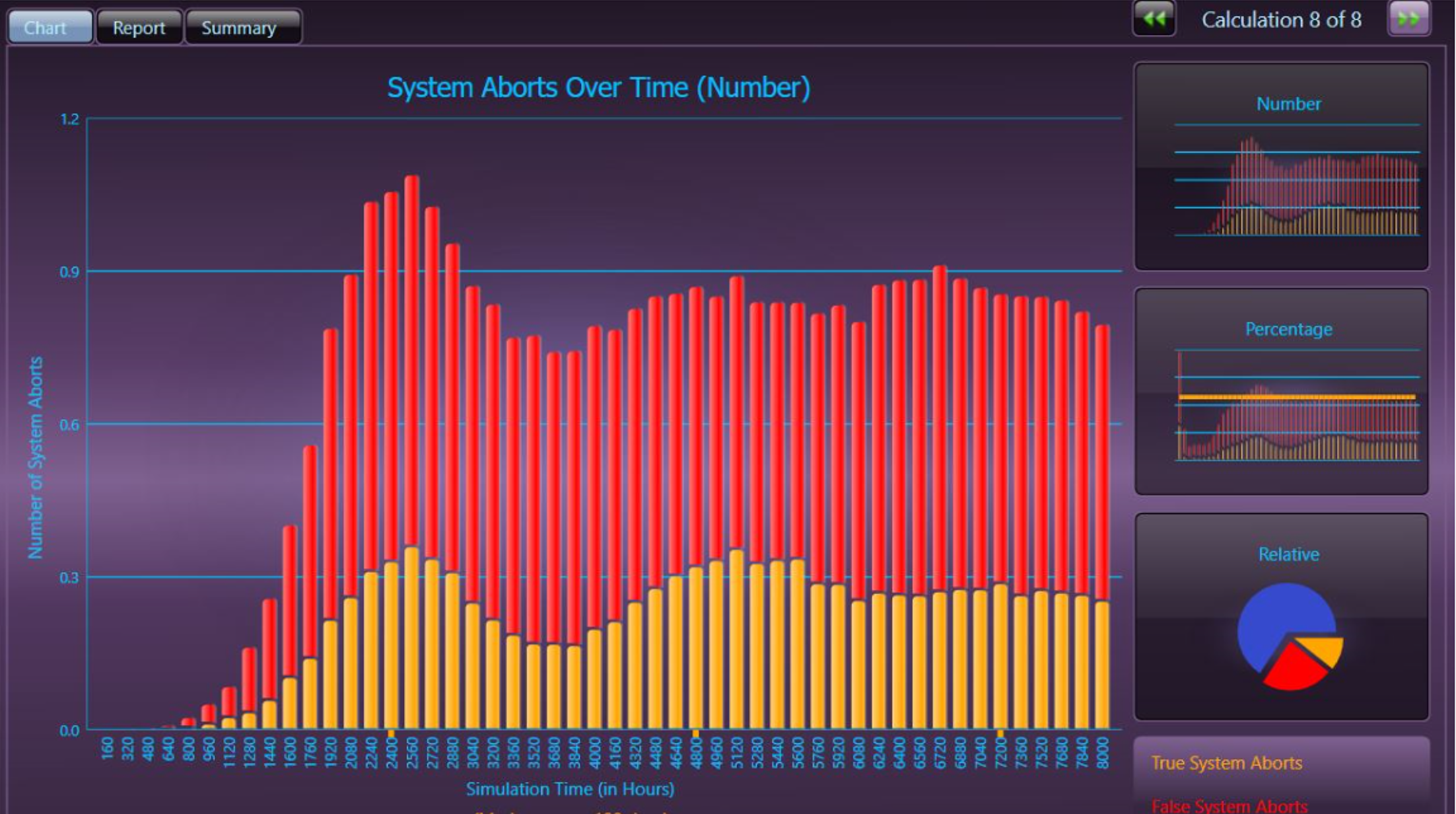
True and False System Aborts (Aborts due to constraints in Diagnostic Design)
Graph considers Replacements due to any Maintenance Activities
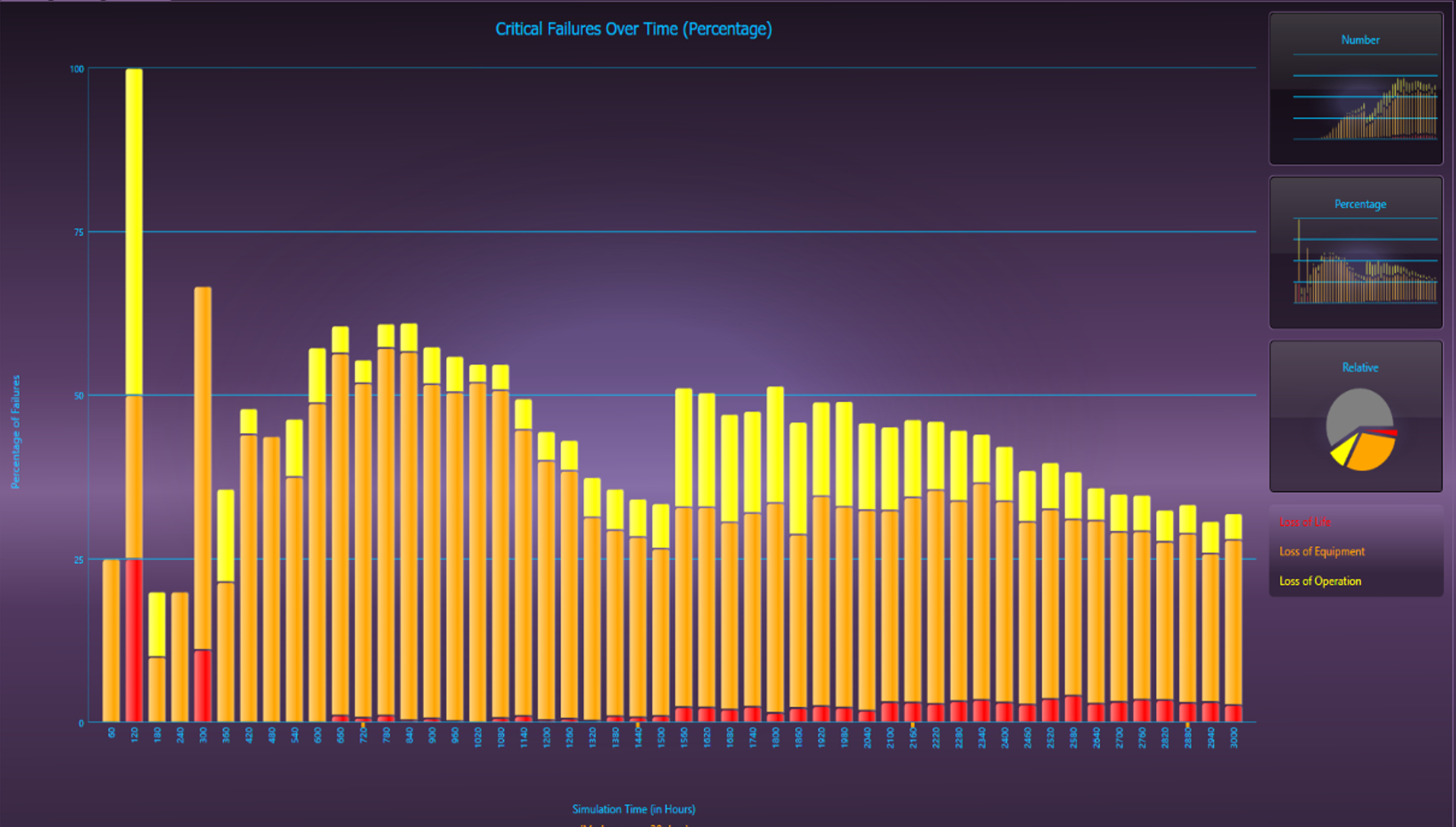
Critical Failures (Simulates the expected Critical Failures in accordance to Severity)
Graph considers Replacements due to any Maintenance Activities
Impact of Prognostics (and PHM) on Corrective Actions as determined in MBSA
The MBSA must be able to consider the “impact of Prognostics Design” at any time during the Development Lifecycle.
To this end, MBSA must be able to consider the operational effectiveness of very low-level Physics of Failure (PoF) analyses for Safety and Risk Mitigation objectives. This area of PHM can become extravagant or ineffective if not strictly worked within the structure of a full MBSE process that is around an MBSA, and is accountable to the operational effectiveness in the sustainment environment. This accountability can be examined, once again, by using Diagnostics Engineering as a means to provide operational and maintainability effectiveness assessments during design development.

Effectiveness of PHM in an MBSA
The first step is to determine the best candidates for Health Monitoring or Health Management at the operational asset level. With this approach to using MBSA, investment into development of advanced sensor technologies is based upon the “diagnostic effectiveness” of the proposed BIT to be used for any PHM application. PHM candidates can be selected on the basis of safety, risk mitigation and operational value (high non-recurring development costs), rather than solely on the size of the corresponding PHM budget.
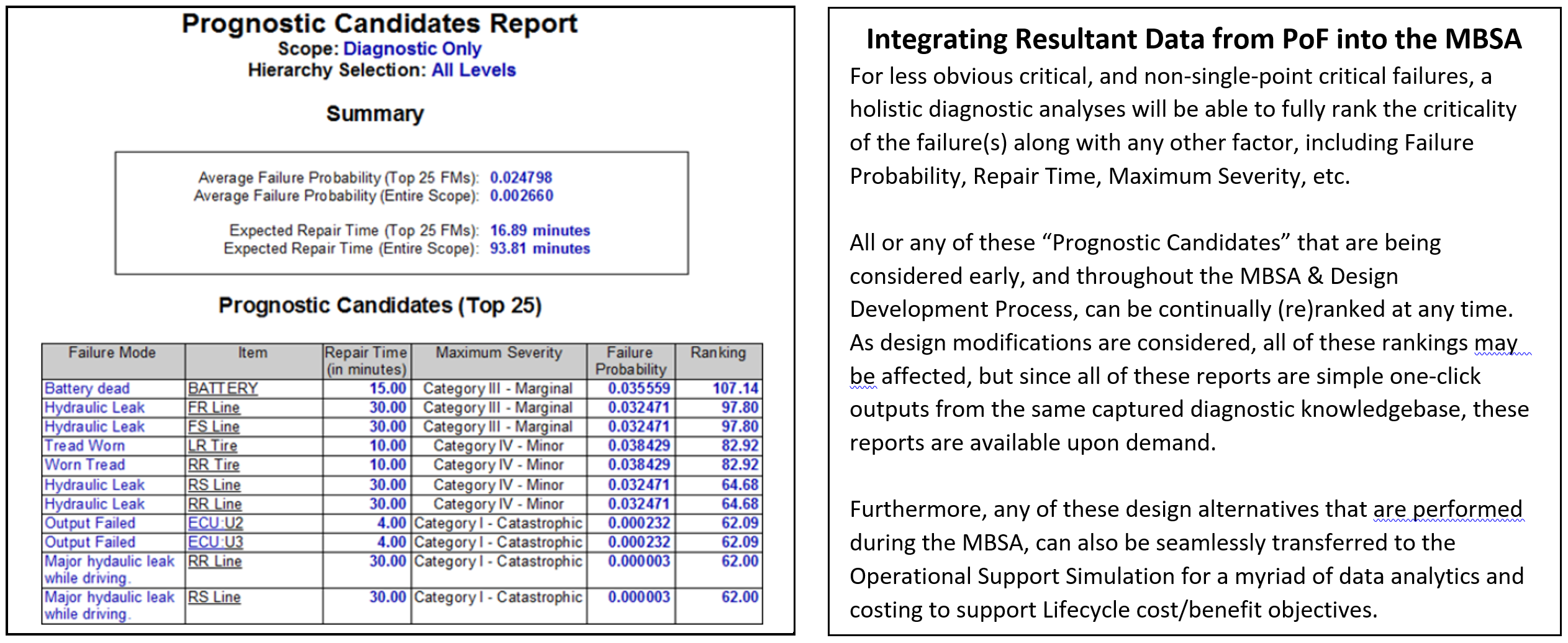
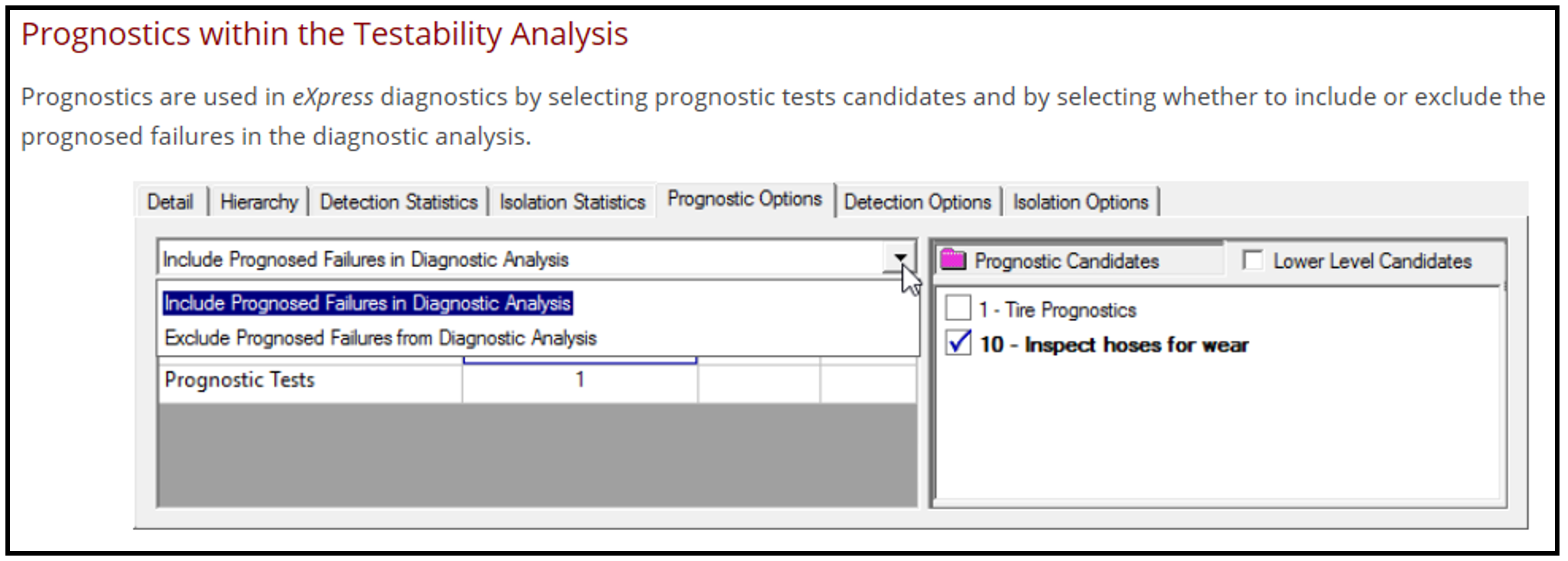
Impact of PHM in an MBSA
Since the high-end Diagnostics Engineering capability is able to determine the Test Coverage of any (proposed or deployed) sensors or BIT (per operational mode, etc.) and is fully cognizant of the propagations of any failure to the lowest root cause, it is able to immediately generate turnkey outputs of the FTA that considers PHM in the MBSA – per cut set.
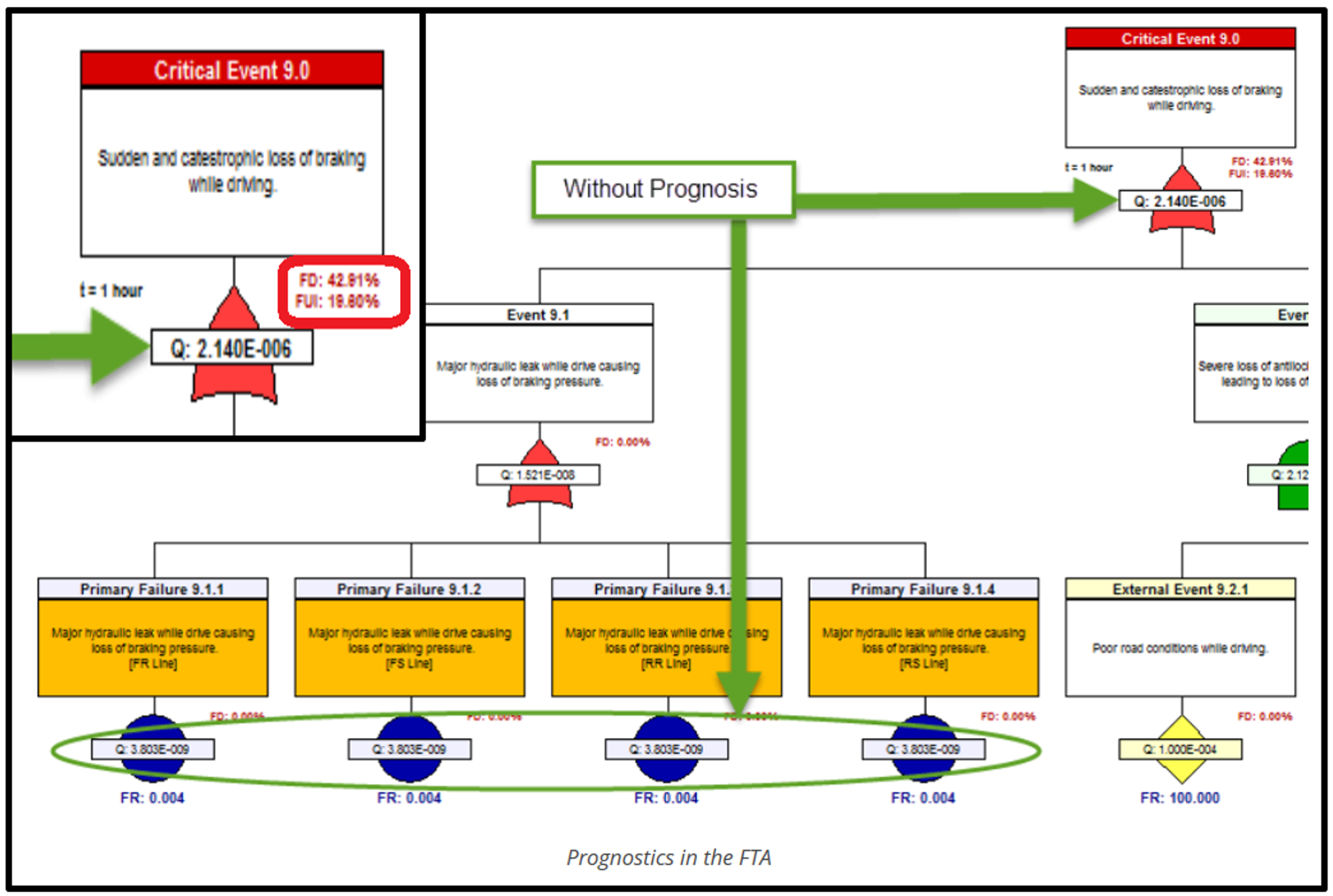
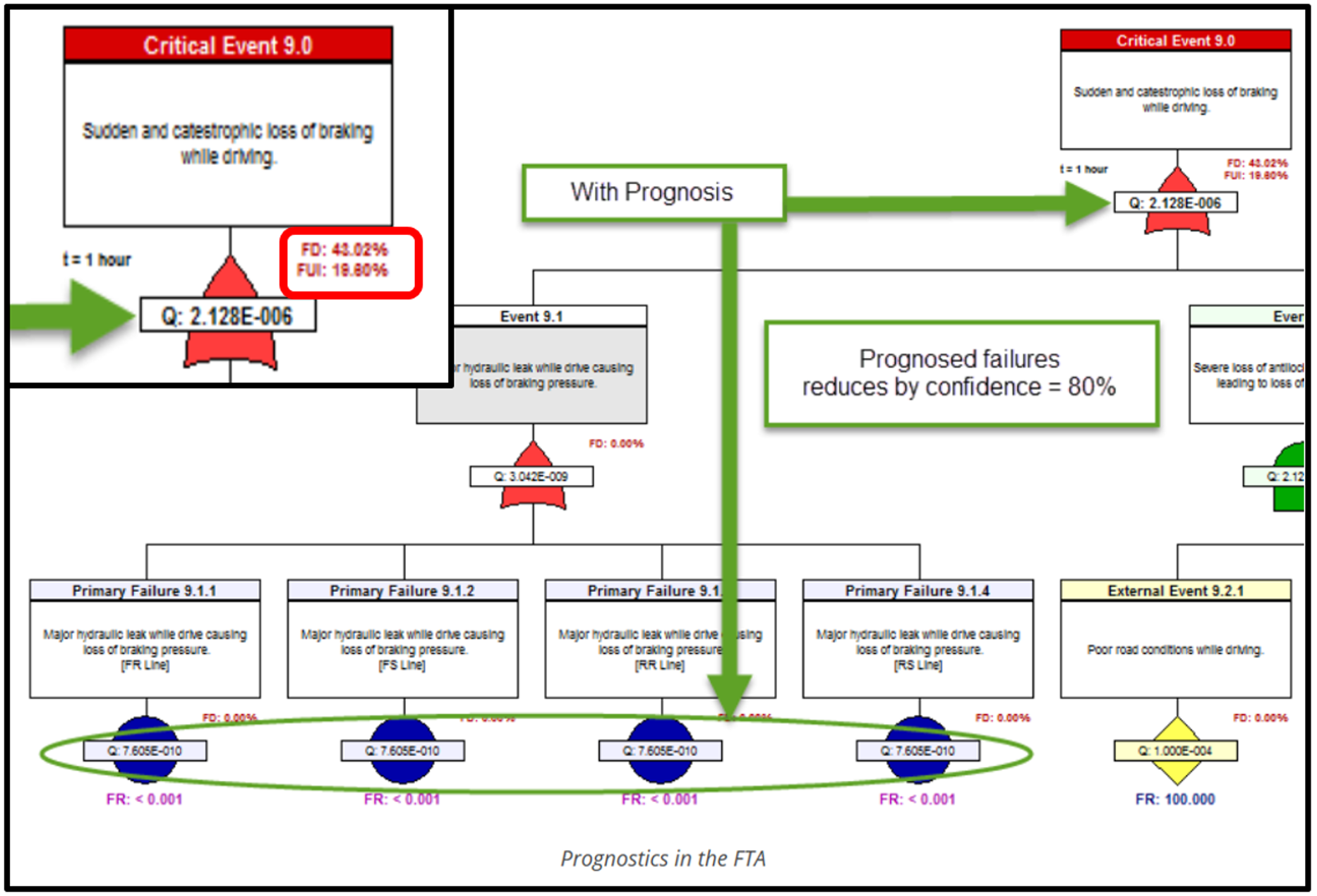
Impact of PHM in an MBSA
In the images above, the top image easily identifies the single-point failures in a mode where the FTA fills the region with an orange color, which signifies that PHM may benefit by drawing attention to these areas. Then, when the results from any PoF analysis (or using, less specifically, historical data) are able to be factored into the captured Diagnostic Engineering knowledgebase, their contribution to the reduction in the likelihood of experiencing a critical failure is immediately computed for each impacted cut set.
The most overlooked contribution that Diagnostics Engineering brings to this FTA portion of the MBSA is that it determines the capability of the PHM to detect and identify the root failure cause(s) within each specific branch or cut set of the FTA. Too often, the Safety Analysis is performed and there’s no “certainty” to the actual portion, if any, of critical failure(s) is able to be observed by the on-board BIT used with or without specifically developed PHM-targeting sensors.
Auto-Assign & Manage (BIT) Fault Codes – Accurately indict failing component(s)
In this solution, the BIT Fault Codes can be associated directly to the fault group and/or the root failure mode during MBSA. By using the full hierarchical knowledge of the system’s diagnostic constraints, this approach uniquely determines which root failures are observed by the BIT, those that are not, and when certain root failures may not be covered in the BIT (see “FUI”).
Enriching BIT Fault Codes “entry points” with Diagnostic Heath Status Knowledge
Additionally, when performed in a high-end MBSA application, BIT codes enable the diagnoses to be “continued” from the on-board PHM capability to the off-board Automatic or Manual Testing implementation(s). This is performed without losing any diagnostic integrity in the transitioning from one paradigm to the next. Replacing the correct failing component(s) in any ensuing maintenance activity provides an optimum method to mitigate safety risks due to mis-isolation of critical failures.
PHM-Informed MBSA
The prerequisite for the assessing of the expected operational value of PHM-informed MBSA is to, again, leverage the diagnostic engineering currency:
1) “Select” Prognostic Candidates
2) “Discover” the impact on Risk Mitigation in the FTA
3) “Balance” PHM with any other mix of maintenance requirements, strategies (RTF, RCM, CBM, PdM) and costing
4) “Transition” optimized MBSA to the operational environment using companion Diagnostic Knowledgebase
Committee members of PHM
DSI is an active (2019) participant in the IEEE SCC20 for developing an Industry Standard in support of PHM.
Existing MBSA Tools Identified in this document
Below is a chart that identifies the commercially Licensable Software tools mentioned throughout this document. While any “Product Lifecycle” ambitions will ultimately be constrained by its effectiveness to transfer such detailed design assurance to the operational environment, restricting to the scope of this inquiry, DSI has thereby not described its commercially available Diagnostic Reasoning tools to accommodate these integral objectives.
